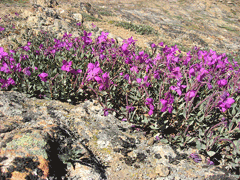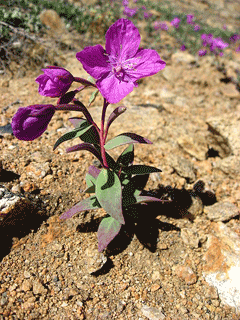 |
|
http://commons.wikimedia.org/wiki/User:Slaunger |
 |
| http://commons.wikimedia.org/wiki/User:Slaunger |
Translate this page:
Summary
Physical Characteristics

 Epilobium latifolium is a PERENNIAL growing to 0.4 m (1ft 4in) by 0.4 m (1ft 4in).
Epilobium latifolium is a PERENNIAL growing to 0.4 m (1ft 4in) by 0.4 m (1ft 4in).
See above for USDA hardiness. It is hardy to UK zone 5 and is not frost tender. It is in flower in July, and the seeds ripen in August. The species is hermaphrodite (has both male and female organs) and is pollinated by Bees.
Suitable for: light (sandy), medium (loamy) and heavy (clay) soils and prefers well-drained soil. Suitable pH: mildly acid, neutral and basic (mildly alkaline) soils. It can grow in semi-shade (light woodland) or no shade. It prefers moist soil.
UK Hardiness Map
US Hardiness Map
Synonyms
Chamaenerion latifolium. (L.)T.Fries.&Lance.
Plant Habitats
Woodland Garden Sunny Edge; Dappled Shade; Cultivated Beds;
Edible Uses
Edible Parts: Flowers Leaves Shoots Stem
Edible Uses: Tea
Young shoots - cooked. Used like asparagus[85, 105, 172]. Very poor quality[2]. Young leaves - raw[172, 183]. They become bitter with age[85]. A good source of vitamins A and C[257]. Flower stalks - raw or cooked. Eaten when the flowers are in bud[85]. The dried leaves are used as a tea substitute[85, 177, 183]. The core of mature stems is eaten raw. Slightly sweet, tender and pleasant tasting[85, 172]. Very fiddly though[85].
References More on Edible Uses
Medicinal Uses
Plants For A Future can not take any responsibility for any adverse effects from the use of plants. Always seek advice from a professional before using a plant medicinally.
Analgesic Antidote Antiinflammatory Antipruritic Antirheumatic Febrifuge
The entire plant is used in Tibetan medicine, it is said to have a bitter taste and a cooling potency[241]. Analgesic, antidote, anti-inflammatory, antipruritic, antirheumatic and febrifuge, it is used in the treatment of fevers and inflammations, plus also itching pimples[241].
References More on Medicinal Uses
The Bookshop: Edible Plant Books
Our Latest books on Perennial Plants For Food Forests and Permaculture Gardens in paperback or digital formats.

Edible Tropical Plants
Food Forest Plants for Hotter Conditions: 250+ Plants For Tropical Food Forests & Permaculture Gardens.
More

Edible Temperate Plants
Plants for Your Food Forest: 500 Plants for Temperate Food Forests & Permaculture Gardens.
More

More Books
PFAF have eight books available in paperback and digital formats. Browse the shop for more information.
Shop Now
Other Uses
References More on Other Uses
Cultivation details
Prefers a well-drained but moisture retentive soil in a sunny position[200]. Succeeds in most soils[1]. The roots are somewhat spreading and the plant can become invasive[233]. The plant is heat tolerant in zones 7 through 3. (Plant Hardiness Zones show how well plants withstand cold winter temperatures.
Plant Heat Zones show when plants would start suffering from the heat.
The Plant Heat Zone map is based on the number of "heat days" experienced in a given area where the temperature climbs to over 86 degrees F (30°C).
At this temperature, many plants begin to suffer physiological damage. Heat Zones range from 1 (no heat days) to 12 (210 or more heat days).
For example Heat Zone. 11-1 indicates that the plant is heat tolerant in zones 11 through 1.) For polyculture design as well as the above-ground architecture (form - tree, shrub etc. and size shown above) information on the habit and root pattern is also useful and given here if available. The plant growth habit is a runner spreading indefinitely by rhizomes or stolons [1-2]. The root pattern is fibrous dividing into a large number of fine roots [1-2].
References Carbon Farming Information and Carbon Sequestration Information
Temperature Converter
Type a value in the Celsius field to convert the value to Fahrenheit:
Fahrenheit:
The PFAF Bookshop
Plants For A Future have a number of books available in paperback and digital form. Book titles include Edible Plants, Edible Perennials, Edible Trees,Edible Shrubs, Woodland Gardening, and Temperate Food Forest Plants. Our new book is Food Forest Plants For Hotter Conditions (Tropical and Sub-Tropical).
Shop Now
Plant Propagation
Seed - sow early spring in situ or as soon as the seed is ripe. Division in spring or autumn. Very easy, larger clumps can be replanted direct into their permanent positions, though it is best to pot up smaller clumps and grow them on in a cold frame until they are rooting well. Plant them out in the spring.
Other Names
If available other names are mentioned here
Native Range
TEMPERATE ASIA: China, Eastern Siberia, Honshu, Japan, Kamcatskij kraj, Kazakhstan, Kyrgyzstan, Magadanskaja oblast, Russian Federation, Russian Federation-Eastern Siberia, Russian Federation-Western Siberia, Tajikistan, Western Siberia, Xinjiang Uygur Zizhiqu, Xizang Zizhiqu (east), Yunnan Sheng (northwest),Afghanistan. TROPICAL ASIA: India, Jammu and Kashmir, Nepal, Pakistan, NORTHERN AMERICA: Canada, Northwest Territories, Yukon, Québec, Ontario, Newfoundland and Labrador, Alberta, Manitoba, British Columbia, United States, Alaska, Colorado, Idaho, Montana, Oregon, Washington, Wyoming, California, Nevada, Utah, Greenland , EUROPE: Iceland, Russian Federation-European part, European part,
Weed Potential
Right plant wrong place. We are currently updating this section.
Please note that a plant may be invasive in one area but may not in your area so it's worth checking.
Conservation Status
IUCN Red List of Threatened Plants Status :

Growth: S = slow M = medium F = fast. Soil: L = light (sandy) M = medium H = heavy (clay). pH: A = acid N = neutral B = basic (alkaline). Shade: F = full shade S = semi-shade N = no shade. Moisture: D = dry M = Moist We = wet Wa = water.
Now available:
Food Forest Plants for Mediterranean Conditions
350+ Perennial Plants For Mediterranean and Drier Food Forests and Permaculture Gardens.
[Paperback and eBook]
This is the third in Plants For A Future's series of plant guides for food forests tailored to
specific climate zones. Following volumes on temperate and tropical ecosystems, this book focuses
on species suited to Mediterranean conditions—regions with hot, dry summers and cool, wet winters,
often facing the added challenge of climate change.
Read More
Expert comment
Author
L.
Botanical References
43200
Links / References
For a list of references used on this page please go here
Readers comment
| Add a comment |
|
If you have important information about this plant that may help other users please add a comment or link below. Only comments or links that are felt to be directly relevant to a plant will be included. If you think a comment/link or information contained on this page is inaccurate or misleading we would welcome your feedback at [email protected]. If you have questions about a plant please use the Forum on this website as we do not have the resources to answer questions ourselves.
* Please note: the comments by website users are not necessarily those held by PFAF and may give misleading or inaccurate information.
To leave a comment please Register or login here All comments need to be approved so will not appear immediately.
|
Subject : Epilobium latifolium
|
|
|
|